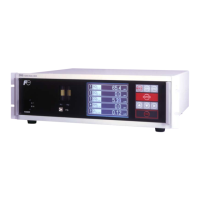9
INZ-TN2ZRE-E
Analyzer without O
2
measurement
N
2
gas
Gas with concentra-
tion of 90% or more
of full scale
Analyzer with built-in O
2
sensor
N
2
gas
Gas with concentration of
90% or more of full scale
Gas with concentration of
90% or more of full scale
or atmospheric air (21%)
Analyzer with external zirco-
nia O
2
sensor
Dry air
Gas with concentration of 90%
or more of full scale
O
2
gas of 1 to 2%
Zero gas
Span gas other
than for O
2
measurement
Span gas for O
2
measurement
(1) Dust contained in the sampling gas should be completely removed with a lter. For the nal
stage lter, use a lter that allows removing dust particles of 0.3µm.
(2) Dew point of the sampling gas must be lower than the ambient temperature to avoid occur-
rence of drain in the gas analyzer. If vapor is contained in the sampling gas, dew point should
be lowered to 2˚C by using a dehumidier.
(3) If SO
3
mist is contained in the sampling gas, use a mist lter or cooler to remove SO
3
mist.
Other mists should be removed by using a mist lter or gas dryer.
(4) Corrosive gases such as Cl
2
, F
2
and HCl, if they are contained in the sampling gas in consider-
able amounts, will shorten the life of instruments.
(5) Temperature of the sampling gas should be within 0 to 50˚C. Pay attention not to ow hot
gas directly into the instrument.
Flow of sampling gas should be 0.5L/min ± 0.2L/min.
Avoid ow uctuation during measurement.
Observe the ow reading by a owmeter provided as shown in the example of the sampling sys-
tem conguration (Item 3.4.6).
Routine calibration is required by standard gas for keeping this instrument under normal operation
condition (once a week). Prepare a standard gas cylinder for zero calibration and span calibration.
The inside of instrument need not be purged generally except for the following cases.
(1) A combustible gas component is contained in the sample gas.
(2) Corrosive gas is contained in the atmospheric air at the installation site.
(3) The same gas as the sample gas component is contained in the atmospheric air at the installa-
tion site.
In such cases as above, the inside of analyzer should be purged with the air for instrumentation
or dry N
2
.
Purging ow rate should be about 1L/min.
If dust or mist is contained in purging gas, it should be eliminated completely in advance.

